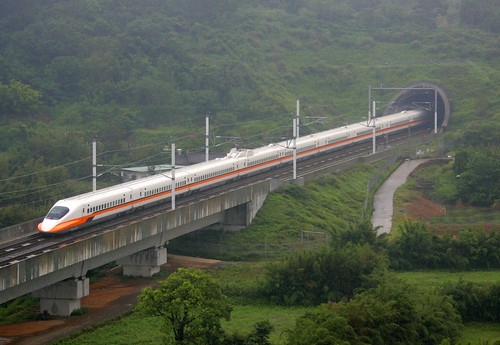The issue of a high speed rail line down the east coast of Australia has recently been raised by each of the 4 major political parties as a potential solution to Australia's need to reduce greenhouse gas emissions, reduce road congestion, promote regional development and cater for a population that is expected to increase to 36 million people by 2050. As a step towards an electrified transport system it would also help as a peak oil mitigation measure, though this aspect only tends to get mentioned by the Greens.
 Infrastructure Partnerships Australia and AECOM recently released a report (pdf) urging the federal government to identity new rail routes and then buy land or put in place planning protections to ensure future land price rises don't make a high-speed rail network a prohibitive option in future (the study indicates the likely land corridor is valued at $13.7 billion at today's prices but will expand to $57 billion by 2030).
Infrastructure Partnerships Australia and AECOM recently released a report (pdf) urging the federal government to identity new rail routes and then buy land or put in place planning protections to ensure future land price rises don't make a high-speed rail network a prohibitive option in future (the study indicates the likely land corridor is valued at $13.7 billion at today's prices but will expand to $57 billion by 2030).
The report won praise in editorials in the Fairfax press, with The Age opining "Whenever the inaugural service glides along its 180-minute path from Melbourne to Sydney and on to Brisbane, it will be worth the time and investment. For too long, rail has been treated as a second-class method of passenger transport, with scant attention paid to its energy efficiency and seamless ability to link city centres. It is time to make it a reality.".
The report took eight months to produce and outlines an indicative corridor where the stations could be located (but suggests that engineering studies would be required to determine the exact location of new routes). It recommends the corridor be built incrementally and shared with different types of infrastructure such as water, electricity and the NBN (national broadband network) to make it financially viable.

The study notes a high-speed rail network allowing a 10-minute trip between Sydney and Campbelltown and a 50 minute trip from Sydney to Canberra would avoid the $15 billion cost of developing a second Sydney airport if construction begins within 5 years, helping the overall economics of the project, as traffic on the Sydney-Melbourne and Sydney-Brisbane routes could
be offloaded. The report says "Travelling between Sydney and Melbourne - currently the third busiest air corridor in the world - could be reduced to less than three hours, showing the exciting capability of fast rail to relieve the pressure on this route".
High Speed Rail As An Election IssueThe recent
federal election saw the
campaign launch for The Greens party included a promise to use their likely balance of power in the Senate to urge the government to reconsider a high-speed rail link along Australia's east coast, pointing to a new poll showing 74 per cent of people favour the idea.
The Greens are
demanding a new $10 million study into the feasibility of a high-speed rail link connecting Melbourne to Brisbane.
The Labor party followed up shortly afterwards with their own announcement of a
feasibility study, promising $20 million for a study that primarily focuses on an initial link between Sydney and Newcastle.

There was some
cynicism expressed about the Labor announcement, with commenters noting the endless link of announced but
never built rail projects for NSW, and the fact that the Rudd government
announced in 2008 that a Very Fast Train for the Sydney-Melbourne corridor, estimated to cost AUD$25 billion, was the government's highest infrastructure priority (only to fall silent on the subject for the rest of their term in office, up until this announcement).
Not to be outdone on the nation building front, the coalition decided to announce their own
backflip on the issue, calling for
a report into high speed rail in response to those of the Greens and Labor, with Nationals leader Warren Truss announcing in waishy-washy fashion "In government the coalition will build upon this study to consider the viability of possible passenger routes along Australia's east coast between Melbourne, Canberra, Sydney and Brisbane".
BenefitsThe Greens are claiming the
following benefits for high speed rail, noting it reduces both oil dependence and greenhouse gas emissions :
1. Provides accessible fast, reliable, ecologically sustainable transport for the 75% of Australia’s population that live on or near the east coast
Travel between Melbourne or Brisbane and Sydney would take about four hours (with comfortable seats, phone and internet access).
2. Helps to reduce transport emissions and dependence on oil
HSR can and should be electric. This means much lower greenhouse gas emissions and unlike air travel, the cost of train travel would be immune from inevitable and inexorable increases in oil prices. It also means that as renewable electricity displaces coal and gas derived electricity, greenhouse gas emissions from transport can be further drastically reduced. To hasten this process the Greens support increasing the Renewable Energy Target by an amount equivalent to the HSR’s electricity demand.
3. Removes congestion and improves transport safety
The Melbourne-Sydney flight route is the fourth busiest in the world and business as usual projections anticipate high growth until at least 2020. The Pacific Highway between Brisbane and Sydney and the Hume and Princes Highways between Melbourne and Sydney have long standing reputations for being hazardous and accident prone, with heavy traffic congestion, which increases the risk of accidents.
4. Basis for future regional development
By reducing transport times relative to road-based transport, an HSR could open up new development opportunities along the route.
5. Opportunities for freight
In most instances traditional slower trains are likely to be the most cost-effective option for rail freight, however, there may be opportunities to use High Speed Rail for some urgent high value freight, such as mail.
6. Job creation
A High Speed Rail network would create a significant number of jobs during the construction phase as well as a smaller number of ongoing positions. During its peak construction period, the Adelaide to Darwin railway employed 1500 people. A larger number of people would likely be required for the construction of a HSR because there would be two tracks built to a much higher engineering standard.
CostsThe Greens are claiming the following costs for the proposal:
• For track work – a range of around $40 billion (inflated to 2008 figures) for a full double track the entire length. Savings could be made by partial use of single track – with variations in the range of -10% to +30%.The report noted that these estimates are in the lower half of international costs on a per kilometre basis.
• For rolling stock – estimate cost of a 400 seat train set around $50 to $120 million (2008 figures). These costs are for passenger stock, and not freight cars, which we could expect to be lower in costs.
• Operating costs assessed on average of about 7-9 cents (2008 figures) per passenger per kilometre.
The Department of Infrastructure and Transport notes that
2 previous studies (other than the recent AECOM/IPA report) have been conducted into high speed rail links for the east coast, however the earlier studies
couldn't show the projects proposed to be "commercially viable" at the time (and continue to be used for ammunition by
critics of high speed rail schemes).
The East Coast Very High Speed Train Scoping Study
A scoping study was commissioned by the Government in December 2000 to conduct a comprehensive examination of options for an East Coast very high speed train network connecting Brisbane, Sydney, Canberra and Melbourne with major regional centers along the way. The Study's Final Report was released in 2002 [PDFPDF: 41942 KB ].
Further information about this study can be found in the Executive Summary for the East Coast Very High Speed Train Scoping Study.
High Speed Rail: Strategic Information for an Australian Context
In 2009, the Cooperative Research Centre (CRC) for Rail Innovation commissioned a study to synthesis the current knowledge of High Speed Rail in the Australian context and to provide directions for further investigation. This report was released on 13 January 2010, and can be accessed on the CRC for Rail Innovation's website.

















